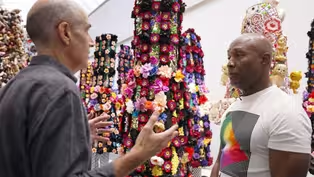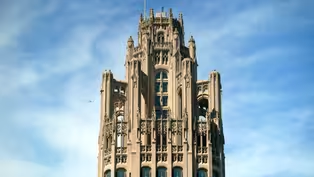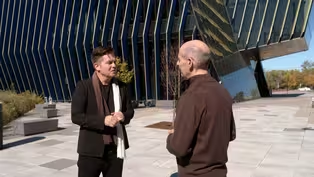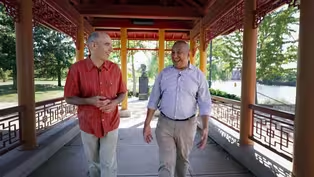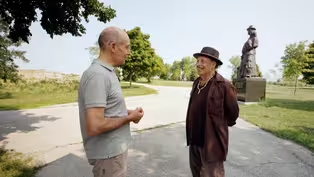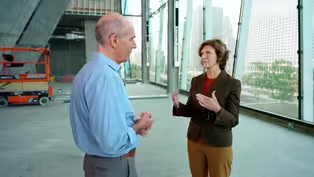
The Rookery with Blair Kamin
Clip: Special | 3m 53sVideo has Closed Captions
Geoffrey Baer visits the Rookery with architecture critic Blair Kamin.
Geoffrey Baer visits the Rookery with architecture critic Blair Kamin. The building was designed by Burnham and Root. Its famous light court was later redesigned by Frank Lloyd Wright.
Problems playing video? | Closed Captioning Feedback
Problems playing video? | Closed Captioning Feedback
Chicago Tours with Geoffrey Baer is a local public television program presented by WTTW

The Rookery with Blair Kamin
Clip: Special | 3m 53sVideo has Closed Captions
Geoffrey Baer visits the Rookery with architecture critic Blair Kamin. The building was designed by Burnham and Root. Its famous light court was later redesigned by Frank Lloyd Wright.
Problems playing video? | Closed Captioning Feedback
How to Watch Chicago Tours with Geoffrey Baer
Chicago Tours with Geoffrey Baer is available to stream on pbs.org and the free PBS App, available on iPhone, Apple TV, Android TV, Android smartphones, Amazon Fire TV, Amazon Fire Tablet, Roku, Samsung Smart TV, and Vizio.
GEOFFREY BAER VO: The Rookery Building in the heart of Chicago's business district has a surprise inside.
On the outside, it's all heavy stone.
But after you enter, and pass the elevators, you emerge into a beautiful space so light and airy, you almost feel like you've gone back outdoors.
There are all sorts of reasons to make a place beautiful.
Here, at least part of the idea behind the beauty was the bottom line, according to Pulitzer Prize winning architecture critic, Blair Kamin.
- [Blair] When you have these big floors, you really need to bring natural light and air into the building in order to make it rentable, in order to make money.
In the mid-1880s, electric light and gas light were very primitive.
So that's the functional reason behind this space, but obviously, the original architects, Daniel Burnman and John Root, then later, Frank Lloyd Wright, elevated that functional need into something truly extraordinary.
- [Geoffrey] So above this ceiling is sort of a hollow space so that the interior offices get light.
- [Blair] Yeah, light and air.
- [Geoffrey] And air?
- [Blair] Don't forget air.
No air conditioning in those days.
You know, air conditioning doesn't really become a factor in office buildings until after World War II.
So if you wanna rent space and make money, you've gotta deal with those practical things.
I mean, art, artful architecture is nice, but the bottom line counts too.
- [Geoffrey] Yeah, well I think you're making a point there, that there's something very Chicago about the practicality behind all this beauty, right?
- [Blair] Yeah, absolutely.
I mean, that is the story of Chicago architecture, elevating the pragmatic into the artistic.
That's what Chicago architects are so skilled at doing.
- VO: For busy office workers who didn't want to wait for the primitive elevators, architects Burnham and Root elevated the utilitarian spiral stairway into a work of art.
The Rookery might have seemed beautiful in 1888, but less than 20 years after it opened, it was already looking dated.
Bad for business.
- [Blair] Originally, this is like a Victorian bird cage that John Root of Burnham and Root designed.
- VO: By 1905, tenants were looking for the next big thing, so the Rookery hired hotshot architect, Frank Lloyd Wright, to give the lobby a facelift.
- [Blair] You really see Wright's hand here, and the way he modernized the space while being respectful to Roots' original.
Wright added characteristic Wrightian touches.
Urns.
Brendan Gill, the critic, once accused Wright of Urnomania.
(Geoffrey laughs) - [Geoffrey] He loved urns.
- [Blair] He loved urns.
And he brings nature into the space on top of the urns, right?
So that's Wrightian.
But also, he uses the marble incised with gold, with the Arabic motif, to lighten and animate.
Wright is simplifying, and he's making it geometric, and it connects to the past, and yet it also anticipates the future.
Wright was brilliant.
And what he did elevated the space even further.
It made it, it accentuated its lightness, its airiness, its ethereal qualities, its contrast with the exterior.
It brought it into the 20th century, literally.
Video has Closed Captions
Clip: Special | 3m 27s | Geoffrey Baer meets Chicago artist Nick Cave. (3m 27s)
The Dazzlingly Ornate BAPS Mandir
Video has Closed Captions
Clip: Special | 2m 40s | Geoffrey Baer tours BAPS Shri Swaminarayan Mandir in Bartlett, Illinois. (2m 40s)
The Delightful Details of Tribune Tower
Video has Closed Captions
Clip: Special | 3m 28s | Geoffrey Baer visits Tribune Tower. (3m 28s)
El Centro with Juan Gabriel Moreno
Video has Closed Captions
Clip: Special | 3m 23s | Geoffrey Baer talks with architect Juan Gabriel Moreno at El Centro. (3m 23s)
Frank Lloyd Wright’s Unity Temple
Video has Closed Captions
Clip: Special | 4m 33s | Geoffrey Baer stops by the Unity Temple in Oak Park. (4m 33s)
Meet Chicago’s Mysterious Mermaid
Video has Closed Captions
Clip: Special | 3m 5s | Geoffrey Baer chats with Roman Villarreal about a once-mysterious mermaid sculpture. (3m 5s)
The Most Beautiful Places In Chicago Preview
Video has Closed Captions
Preview: Special | 1m 1s | Join Geoffrey Baer on an adventure to explore THE MOST BEAUTIFUL PLACES IN CHICAGO. (1m 1s)
Repurposed Parks with Ernie Wong
Video has Closed Captions
Clip: Special | 5m 6s | Geoffrey Baer tours two parks with landscape architect Ernie Wong. (5m 6s)
Steelworkers Park with Roman Villarreal
Video has Closed Captions
Clip: Special | 3m 1s | Geoffrey Baer chats with Chicago artist Roman Villarreal. (3m 1s)
St. Regis Chicago with Jeanne Gang
Video has Closed Captions
Clip: Special | 3m 33s | Geoffrey Baer interviews architect Jeanne Gang at St. Regis Chicago. (3m 33s)
Providing Support for PBS.org
Learn Moreabout PBS online sponsorshipSupport for PBS provided by:
Chicago Tours with Geoffrey Baer is a local public television program presented by WTTW
